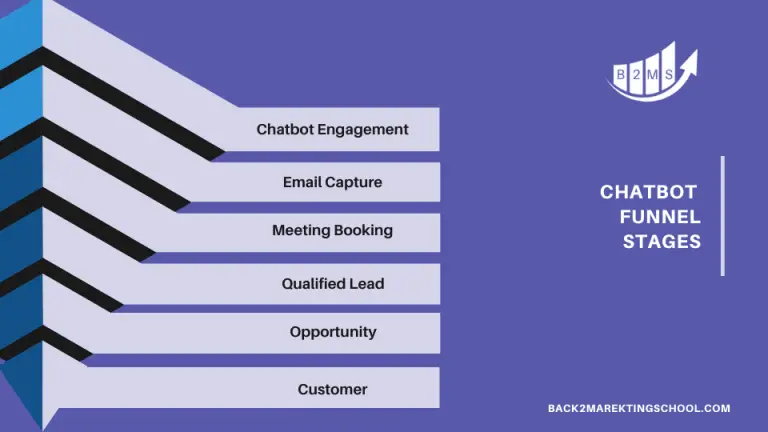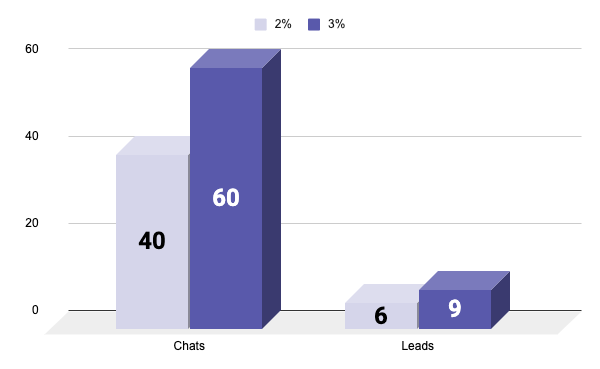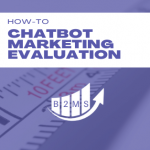19 chatbot marketing hacks that actually optimize performance
Why is chatbot optimization so important?
Optimizing your website’s chatbot conversational marketing is crucial to not just convert more visitors to leads but also qualify those leads for your sales team. Your sales team can personalize the buying experience and close the deals faster and better.
But how do we get there? Let’s step back for a moment and picture the user flow and conversion funnel of your chatbot.

Every stage has a conversion rate to the next. If you optimize one and all other rates stay consistent your overall success rate can increase drastically. Here’s just a small visualization of the impact small changes can have by increasing the hook rate from 2% to 3%:

How can you improve each chatbot success metric? Let’s explore 19 chatbot marketing hacks to optimize your chatflows.
Know your chatbot marketing numbers
Before we can make any tweaks to your chatflows, you need to evaluate your chatbot carefully. Not just the overall numbers but each chatflow itself, and even each path. For example, it could be that one chatbot is converting leads very well but you still lose many visitors in one specific path they take, or that the lead quality is not as good as others.
The benchmarks you should aim for are a 2% to 3% hook rate, 15% to 20% email capture rate, and 3% to 4% meeting book rate.

Improve the chatbot hook rate
This section could be its own blog post by itself. Anyways, I broke it down into 7 tips on how to improve the chatbot hook rate.
- Use conditional branching to address returning visitors differently
- Address customer pain points in the welcome message
- Create curiosity
- Use social proof
- Personalize message by lead source
- Use live chat
- General personalization
1. Conditional branching for returning website visitors
Based on the number of times a user is visiting your website, you can customize the welcome message. (the first message the user sees to click and start a chat)
- First-time visitor: Hi 👋 , can I help you today?
- First-time returning visitor: Welcome back 👋 , are you ready to learn more about X?
- Returning more than once: Hey, you become a regular around here. May I connect you to a human?
2. Address customer pain points in your chatbot hook
This speaks for itself. Instead of offering help, you can state a common problem your ideal customer has.
Some chatbot generic opening line examples are…
- Hi 👋 , do you struggle to achieve X?
- Hey 👋 , can I help you with problem X?
- Hi 👋 , does {problem} sound familiar? or Hi 👋 , do you have {problem}?
- Hi 👋 , if you haven’t achieved X last month, we should talk.
Let’s put these into a specific chatbot marketing technology opening line:
- Hi 👋 , do you struggle to convert your website visitors?
- Hey 👋 , can I help you convert more website visitors?
- Hi 👋 , is your website conversion rate below 4%?
- Hi 👋 , if you haven’t converted 4% of your website visitors last month, we should talk.
3. Create curiosity with your hook
Treat your chatbot welcome message as something the user needs to click to find out what’s going on. Attentional make the message longer that it isn’t fully displayed or ask a provoking question that you answer as soon as they click the chat widget.
4. Utilize social proof
Similar to testimonials, awards, or certifications, a hint of social proof can cause chatbot engagement.
- Hi 👋 , do you want to join a community of 1000 marketers like you?
- Hey 👋 , do you want to know what X has to say about us?
- Hi 👋 , guess which award we’ve just won?
5. Personalize your chatbot welcome message by traffic source
If your website tagging is set up correctly you can pull in traffic source information through UTM parameters or native integrations of your chatbot technology.
- Hi, thanks for stopping by all the way from {source}.
- Hi, what brings you here from {source}.
6. Let a human chat – Live chat widget
Let a human pick up the conversation, and let the visitor know that it’s not a bot but a real person chatting. Just make sure, the person is ready to chat when the user engages.
7. General personalization
Personalization always works. Some chatbots offer reverse IP look-ups or CRM integrations to identify known people or their company. However, with more and more people not working from an office, those tools often miss the IP address and greet people like Amazon or GoDaddy employees. Use with caution.
Also, too much personalization can offset a user and seem creepy.
Optimize chatbot conversion rates – capture more leads
The most important thing for email capture bots is to give people a reason to give you their email addresses. Don’t ask immediately for the contact information after the initial hook. If you say “hi”, they open the chat, and you ask instantly for the email address, chances are the person drops off. Some investment or a real reason why you need the email works well. For example, if someone chats it outside of working hours, you could say “sorry, we are all offline right now. But if you leave your email we will get back to you tomorrow.”
After one or two questions have been answered and maybe even a message was typed into the chat widget by the user, they have invested some time already. Now, they also want to get their question answered and are more willing to give you their email address.
However, don’t make the mistake of waiting too long. After some initial engagement, ask as quickly as possible for the email address. You can ask qualifying questions after an email address has been captured.
Another growth marketing hack is to not treat it as an interview or contact form. Keep it conversational with affirmations, personalization throughout the chat, and as human as possible with emojis and even slang.
- When someone gives you their full name, say “nice to e-meet you, {first-name}”.
- When the bot doesn’t know the answer, use that flaw to your advantage: “Sorry, I’m just a stupid bot and I don’t understand this. May I connect you to a human?”
- After someone selected a predefined option via a button click, make sure to not just jump to the next question but use the previous information to keep it conversational
Most pre-programmed chatflows allow for humans to take over the chat. You can either route a conversation to a team member like an inbound SDR, or have the team watch the chats and jump in to increase the conversion rate. A rule of thumb is to let the chatbot handle the conversation as long as the person is interacting with it.
Chatbot marketing hacks to increase meeting booking rate
With the goal in mind to increase chatbot appointments, you can implement the following three optimization tips:
- Make clear that someone can book an appointment through the chatbot from the beginning. “I can help you to schedule a call with a product specialist. Can you give me your email address, which I can send a calendar invite to?”
- Chatbot meeting abundant sequence: When someone reaches the chatflow step to book a meeting but doesn’t complete it, you must have collected the email address before. You can trigger an email to the lead asking for the meeting. That will save time and increase conversion rates. Think about cart abundant emails of e-commerce marketing.
- Similar to the email capture methodology, ask for the chatbot appointment as early as possible and use qualifying questions after the meeting has been scheduled. Just ask as many to route the conversation to the best team member.
Qualify your chatbot leads better
One advantage of chatbot marketing is that every single data entry gets submitted. As soon as someone enters their email address the lead is captured. On the other hand, this can be a downside because you may end up with only the email address and nothing more.
In the short term, this may seem counterproductive and you want to prioritize contact forms over chatbot marketing on high intent pages, but I guarantee you to miss out. Here are some chatbot marketing hacks to optimize lead information quality.
We covered asking as early as possible for the contact information and keeping it conversational to engage further with the lead. Every time the lead clicks on a predefined button you can save that information to the lead. For instance, the path she is interested in (solution A vs B).
Secondly, you can implement question logics which are hard to build in contact forms. For example, if someone is interested in solution A, it might be important to know how many users they have, which technology they use to integrate with, or what their current marketing spend is. For solution B on the other hand, it might be a small business solution and the number of website visitors may be more important. You get the point: Gather solution-specific information.
Use progressive information in your chatbot marketing. If you know an answer already, skip the question and move on to the next. Of course, forms have the same feature called progressive form filling, but it works in combination with question logic even better.
Some language that can help you to ask for additional information:
- In order to connect you to the right person, could you answer the following 3 questions?
- To help us prepare for the meeting can you tell us a little bit about your situation (we will ask these questions in the discovery call anyways)
- To save us both some time and get you connected to the right person, could you kindly answer some questions?

Sascha is a Lifecycle Marketing Consultant with over 8 years of digital marketing experiences in Silicon Valley, the UK, and Germany.
After leading the demand generation for a 100+ million company, he decided to venture out on himself. He’s now helping clients to attract and convert more leads and customers.
His main focus are SEO, paid media & marketing automation – all with the focus to tie marketing campaigns to revenue.
Sascha has been featured in industry publications.




